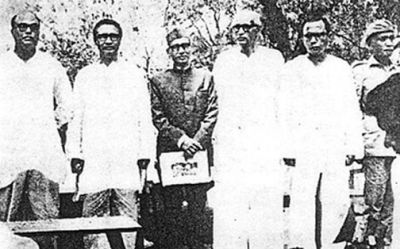Mujibnagar Government
Mujibnagar Government the government constituted at Mujibnagar to conduct the Bangladesh war of liberation, formed on 10 April 1971 after the declaration of independence on 26 March 1971. The Mujibnagar government headed by tajuddin ahmad took oath on 17 April 1971 at Mujibnagar. This government had also been known as Mujibnagar Government in-exile, as the activities of the government had been conducted from outside of the territory of Bangladesh.
Formation of the government On 10 April a government was formed consisting of the top ranking leaders of awami league. The oath taking ceremony of the government took place on 17 April at Baidyanathtala, in the district of Meherpur. The oath taking ceremony was conducted by Abdul Mannan MNA and the proclamation of independence was read out by Professor mohammad yusuf ali. In this place a guard of honour was given to syed nazrul islam, the Acting President of the newly formed government.
Assignment of portfolios Although the government was formed on 10 April and its oath was taken on 17 April 1971, the portfolios were assigned among the ministers on 18 April. The incumbents of the government were:
| Bangabandhu Sheikh Mujibur Rahman | President |
| Syed Nazrul Islam | Vice President, (Entrusted with the powers, functions and responsibilities of the President since the President himself was then detained in Pakistan). |
| Tajuddin Ahmad | Prime Minister, In charge of Defence, Information, Broadcasting and Communications, Economic Affairs, Planning Division, Education, Local Government, Health, Labour, Social Welfare, Establishment as well as other affairs the responsibility of which was not yet entrusted to any one. |
| Khondakar Mostaq Ahmad | Minister, Ministry of Foreign Affairs, Law and Parliamentary Affairs. |
| M Mansur Ali | Minister, Ministry of Finance, Industry and Commerce. |
| AHM Qamaruzzaman | Minister, Ministry of Home, Civil Supplies, Relief and Rehabilitation, Agriculture. |
Mujibnagar government was divided into fifteen ministries and divisions. Besides, some divisions were placed under the Cabinet. The functions of the ministries and divisions were:

Ministry of Defence Staff MAG Osmany, Commander-in-Chief; SA Samad, Defence Secretary; Colonel Abdur Rab, Chief of Staff. The Ministry of Defence divided the war zone into eleven sectors and appointed a sector commander for each of the sectors. But there was no sector commander for sector No 10 or naval sector. Commandos used to fight under the command of the concerned sector commander whenever and wherever they carried out the operation in a particular sector. Besides, there were three brigades called Z force, K force and S force. Major Ziaur Rahman, Major Khaled Mosharraf and Major Km Shafiullah were the commanders of the brigades respectively.
Ministry of Foreign Affairs sought to obtain support of the foreign governments and people at large for the cause of liberation of Bangladesh by establishing Bangladesh mission abroad and by sending diplomatic emissaries to various countries. With this end in view diplomatic missions were established in Kolkata, Delhi, London, Washington, New York, and Stockholm. Diplomatic delegations were sent to the UNO, Afghanistan, Syria, Lebanon, Nepal, Srilanka, Burma, Thailand and Japan for gaining their support to the liberation war.
Ministry of Finance, Industry and Commerce was headed by M Mansur Ali and Khondaker Asaduzzaman was its secretary.
Cabinet Secretariat placed various proposals about the operation of the liberation war to the cabinet meeting, implementation of' the decisions of the meeting, and monitoring and recording these decisions. HT Imam was the secretary of the ministry.
General Administration Division was formed under the Ministry of Establishment to deal with appointment, transfer, promotion and framing of service rules. Nurul Qader was the secretary of the Establishment Division.
Zonal Administrative Council was formed under General Administration Division. Nine administrative zones with a chairman for each were' formed to look after administration of lubrication war activities. Each zone had a headquarters, and a chairman.
Ministry of Health and Welfare worked under a Director General. Later the position of the Director General was elevated to the status of a secretary. The functions of the health department was divided into two sectors: a) to impart medical treatment to the freedom fighters under the army ie under the Ministry of Defence and b) to render medical treatment to such civilians or persons who did not participate in the liberation war directly with arms.
Ministry of Information and Broadcasting played important role to build up public opinion in favour of the liberation war. This ministry used to perform its functions through four divisions: a) Radio (swadhin bangla betar kendra), b) Films, c) Publications, d) Fine arts and design.
Ministry of Home was responsible for maintaining law and order in the liberated areas. This ministry selected the uniform, badge and monogram of the Bangladesh police force. Abdul Khaleque was made the first IG of the police and was later appointed as home secretary.
Relief and Rehabilitation Division was created under the supervision of the Ministry of Home and Ministry of' Relief with a view to rehabilitate the refugees taking shelter in India.
Parliamentary Affairs Division worked under the ministries of Foreign Affairs and Law and Parliamentary Affairs. The main task of this division was to solve various problems of the members of Provincial and National Assembly and to engage them in various activities.
Agriculture Division worked for finding ways and means for taking measures to overcome food crisis by increasing food production in the post-war Bangladesh, introducing scientific cultivation and providing loans to farmers under easy terms in view of the wartime losses. [Mohammad Faiquzzaman]
Bibliography HH Rahman, Bangladesher Swadhinata Juddha: Dalilpatra, Dhaka, 1982; ht Imam, Bangladesh Sarkar 1971, 2004; Nurul Kader, Ekattor Amar, 1999; Shamsul Huda Chowdhury, Muktijuddhe Mujibnagar, 1985; BB Biswas, Ekattore Mujibnagar, 2000; Mohammad Faiquzzaman, Mujibnagar Sarkar o Bangladesher Muktijuddha, Dhaka, 2008.
